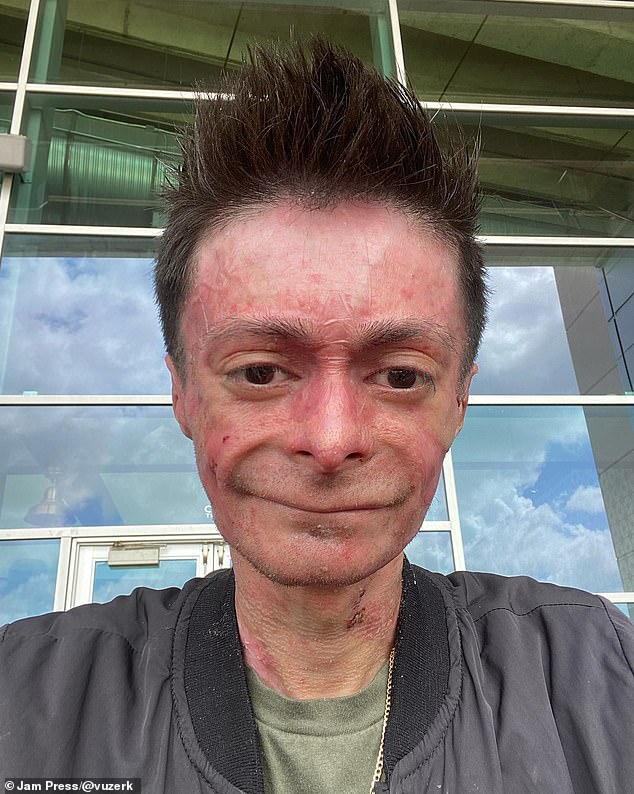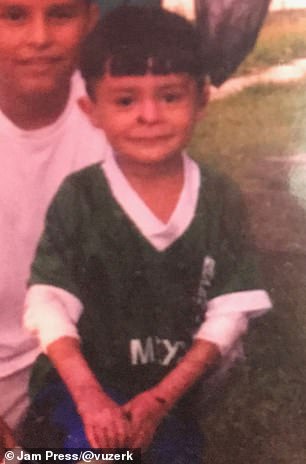Touch of death: Man, 28, with rare skin condition that leaves agonizing wounds at the slightest graze and could kill him in his 30s says even ‘walking and eating are a constant battle’
A man with a rare skin condition revealed his skin is so fragile it can tear at the slightest touch.
Victor Hugo Quiroz, 28, was diagnosed at birth with Recessive Dystrophic Epidermolysis Bullosa (EB), a genetic condition that has left him with extremely fragile skin and webbed feet on his hands and feet.
The condition causes the skin to become very fragile because the skin layers do not bond normally the slightest abrasion causes the outer layers to tear off, leaving painful blisters and deep wounds similar to third-degree burns.
Cycles of blisters and scars on hands and feet can cause them to stiffen. The scar tissue can become so thick that fingers or toes fuse together and become webbed.
Victor said: “Sometimes it's things that most people take for granted, like walking or eating. It's an ongoing daily struggle.”
Victor is a content creator from Houston, Texas. He was diagnosed with recessive dystrophic epidermolysis bullosa (EB) at birth

EB is the name for a group of rare hereditary skin conditions that affect one in 50,000 people and cause the skin to become very fragile. This means that the slightest abrasion will cause the outer layers of the skin to peel, causing painful blisters and deep wounds that look like third-degree burns
EB is the name for a group of rare hereditary skin conditions that affect one in 50,000 people and cause the skin to become very fragile.
Exact numbers are unclear, but estimates suggest that between 25,000 and 50,000 people in the US have EB. People suffer from the condition to varying degrees, with some mild forms that may improve with age.
Victor has to change his bandages daily, apply ointment and see his doctor as often as possible.
Currently, there is no cure for EB and life expectancy is said to be only 30 years.
Victor said: 'There are treatments available, some have even been approved, but no real cure has been found.
'Like many others with EB, I was told at birth that I had only a few weeks to live, and yet here I am at the age of 28 with so many achievements, so many things to be proud of.'
The condition has greatly affected his quality of life.
“I often have blisters, open wounds, infections and cuts,” the content creator from Houston, Texas told NeedToKnow.co.uk.
'One of my other symptoms is that my hands and feet have webbed feet, as well as changes in the pigmentation of my skin.

Victor Hugo Quiroz as a child
'Changing a bandage on my body, popping a blister or doing everyday things that my EB makes a little more difficult, such as opening a bottle of water.'
Growing up, Victor had a relatively normal childhood and didn't let EB get in the way of him enjoying life with friends.
He said, “I have always appreciated my mother, who was not afraid to let me be a child. Even though I would get hurt, she allowed me to have fun and test my limits with my body.
'It really allowed me to learn to be independent and learn what I could and couldn't do.
'I have fond memories of playing football in the street every day after school until I literally couldn't kick the ball anymore because of the bad blisters on my feet. EB controls my life.'
But the condition has also had a deeper effect on his mental health.
Victor said: 'By far the most difficult obstacle with EB is my mental health; Even though I preach and do my best to always be positive and uplifting, I would be lying if I said I was like that 100 percent of the time.
'EB is not an easy condition to live with by any means… it can be extremely overwhelming and exhausting.
But Victor insists that he will not let his condition limit him more than is strictly necessary.
He said: 'It's made me mature a lot younger, I've been through so much since the moment I was born and I'm proud of myself.
“When I was a teenager, I gave myself two choices: I could either live my life feeling sorry for myself and let EB control every aspect of me, or I could make the best of the life I have and live it to the fullest.
“In so many ways I feel blessed to have the life I have and I truly feel that if I didn't have EB, I wouldn't be the same positive, happy and grateful person I am today.”
He has also succeeded in many parts of his life, including traveling the world alone, visiting Croatia and states like Florida and California.
Victor said: 'I'm most proud of my independence, from traveling the world alone to traveling all by myself without help from anyone.
'I can honestly say I'm proud of myself and grateful for everything I can do despite my EB – it's something I never take for granted.
“I have exceeded the expectations of many and I know I will continue to do great things.”
He added: 'I've managed to turn my passion into a career, I've spoken to huge audiences, I've entertained thousands of people online and if I can do it, I know everyone else can do it too.
'Don't let anything stop you from achieving your goals, you never know what you can achieve until you go for it.
'Everything is possible, I have always said that and I will continue to do so.'
